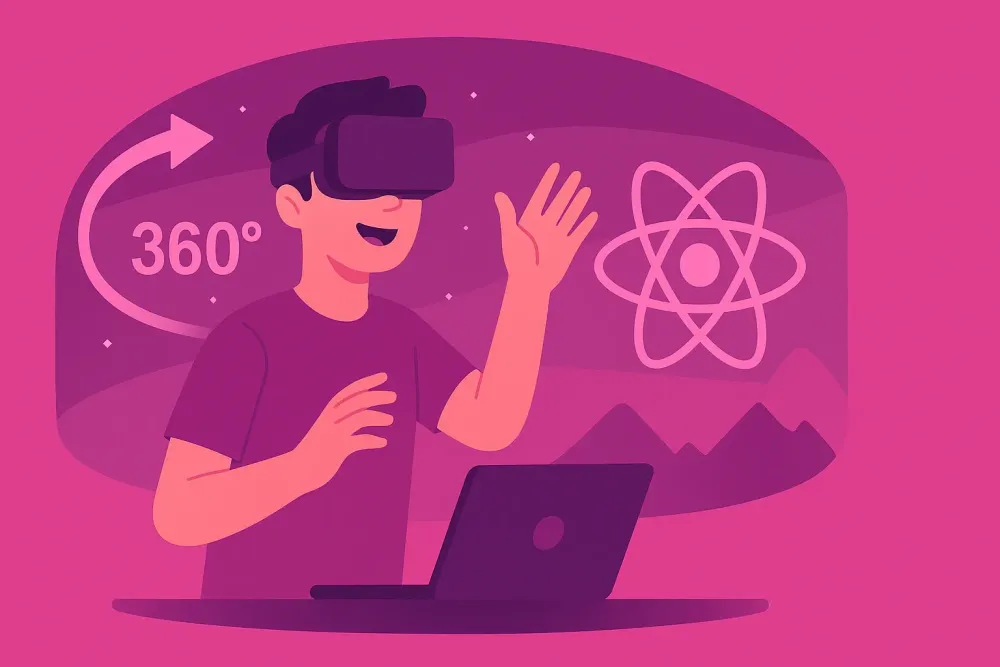Home
Services
Products
Projects
Who We Are
Blogs
Contact Us

Harnessing the Power of 360° Experiences with React 360
What is React Native?
React Native is an open-source mobile application development framework created by Facebook. Designed for building applications across Android, iOS, Web, and UWP, it empowers developers to leverage React's capabilities alongside native platform performance. As a JavaScript framework, React Native facilitates the creation of truly native mobile apps for both Android and iOS. As of June 2019, React Native held a significant 42% market share in mobile application development. It's a particularly attractive choice for developers proficient in JavaScript, eliminating the need to learn platform-specific languages like Java for Android or Swift for iOS.
What is React 360?
React 360 is a framework specifically designed for crafting immersive 3D and VR user interfaces. Built upon React, a library known for simplifying complex UI development, React 360 allows developers to use familiar tools and concepts to create compelling 360° content for the web.
What are its Applications?
React 360 excels in building interfaces that drive rich multimedia experiences. It provides the tools necessary to create high-quality interactions and offers a robust infrastructure for applications centered around 360° and 3D content. The implementation and tools within React 360 are similar to those used by Oculus and Facebook in developing their own VR applications for mobile and PC platforms, representing the culmination of years of research and development.
Exploring Best Practices and Use Cases
React 360 is all about bringing interactivity to 360° spaces. Applications incorporating 2D or 3D interfaces are readily achievable. Photo and video viewers, virtual 360° tours, classic adventure games, and 3D board games are just a few examples of what's been built with React 360.
How Does React 360 Differ from React VR?
In 2017, Facebook and Oculus introduced "React VR," a JavaScript library for building 3D and VR experiences within web browsers. Concurrently, Oculus began utilizing a native C++ version of the framework for their first-party apps. As the APIs of the two projects diverged to meet different development needs, the open-source framework was renamed "React 360" to better reflect its core purpose: creating immersive 360° experiences accessible across PC, mobile, and VR devices. Developers familiar with React VR will find React 360 very similar. Many common systems, like embedding 2D UI elements within 3D space, have been streamlined and optimized. Migration from existing React VR apps to the new tooling is also straightforward.
How Does React 360 Differ from A-Frame?
A-Frame is a framework for building VR experiences using custom HTML-like components. It boasts a rich component library from a vibrant community and is well-suited for complex 3D scenes viewable in VR. React 360, however, is better suited for applications heavily reliant on user interaction or event-driven logic, especially those incorporating numerous 2D or 3D UI elements. A-Frame might be a better choice for applications with complex 3D models, shaders, or post-processing requirements. Both frameworks enable the creation of compelling, VR-ready experiences.
How Does React 360 Differ from Three.js?
Three.js is a lower-level library for 3D rendering in web browsers, offering direct control over 3D meshes and textures. React 360 abstracts much of this complexity, allowing developers to focus on application behavior and presentation. While React 360 currently utilizes Three.js for some rendering tasks, future API updates will allow developers to choose their preferred 3D rendering library, even using raw WebGL calls.
360° Photos and Videos
React 360 is optimized for displaying 360° (and 180°) photos and videos, fundamental elements for creating immersive environments. In-line flat video embedding is also supported. This focus on panoramic media reflects how most developers utilize the framework and acknowledges the large non-VR audience reachable with React 360 content. The rebranding from React VR to React 360 clarifies the project's future roadmap and emphasizes its broader applications beyond VR.
Pixel-Perfect 2D
Creating 2D interfaces in 3D space is now simplified with the introduction of Surfaces. These UI panels integrate seamlessly, enabling pixel-based design (instead of meters), compatibility with standard design tools, and even code portability from React Native. These panels utilize the same UI principles as Oculus applications and are optimized for precision.
Improved Media Support
Enhanced features for immersive media include support for 180° mono and stereo video, built-in transitions, and faster loading times. Developers gain finer control over their application's presentation, making interactive panoramic media experiences easier to implement.
Better Performance
A rebuilt runtime significantly improves performance, enabling support for lower-end devices, boosting frame rates, and minimizing garbage collection. Further optimizations are planned to expand reach across a wider range of web-enabled devices.
Installation
Install react-native-360 via npm:
npm install react-native-360 --save
In the iOS folder, create a Podfile.
target 'myProject' do
pod 'GVRSDK/GVRView'
pod 'React', :path => '../node_modules/react-native', :subspecs => [
'Core',
'RCTImage',
'RCTNetwork',
'RCTText',
'RCTWebSocket',
]
endInstall and update pod details
pod install
pod updateImport below in your screen
import { VideoView } from 'react-native-360';Add below view in your screen
<VideoView
style={{ height: 200, width: width }}
video={{ uri: 'ADD YOUR 360 VIEW VIDEO URL HERE', type: 'stereo' }}
displayMode={'embedded'}
volume={1}
enableFullscreenButton
enableCardboardButton
enableTouchTracking
hidesTransitionView
enableInfoButton={false}
/>Conclusion
React 360 empowers developers to create immersive, interactive environments that redefine how users engage with digital content. From virtual tours and training modules to immersive storytelling and product showcases, the possibilities are endless. By leveraging React 360, you can bring powerful VR experiences to the web with the tools you already know and love.
At DEFX, we specialize in building cutting-edge 360° and VR applications that elevate user engagement and deliver memorable experiences. If you're ready to harness the power of immersive technology for your business, contact DEFX today — let's bring your vision to life.
See More
Contact Us
Let’s make your Idea into Reality
Let's Talk
© Copyright DEFX. All Rights Reserved
GoodFirms ★ 4.2
Clutch ★ 4.2
Google ★ 4.2
